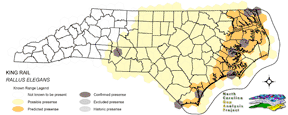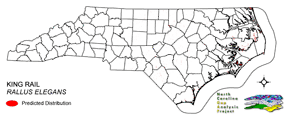
| Taxa: |
| Order: |
| Family: |
| Aves |
| Gruiformes |
| Rallidae |
| NatureServe Global Rank: |
| NatureServe State (NC) Rank: |
| G4G5 |
| S3B,S3N |
| Federal Status: |
| NC State Status: |
| --- |
| W1,W3 |


| Land Unit |
| US Fish & Wildlife Service |
| US Forest Service |
| US National Park Service |
| US Department of Defense |
| NC State Parks |
| NC University System |
| NC Wildlife Res. Com. |
| NC Forest Service |
| NC Div. of Coastal Mgmt. |
| Local Governments |
| Non-Governmental Org. |
| Other Public Lands |
| Private Lands |
| GAP Status 1-2 |
| All Protected Lands |
| Statewide |
| Hectares |
| 20,131.47 |
| 291.78 |
| 10,597.14 |
| 6,263.91 |
| 1,308.60 |
| 152.19 |
| 5,041.80 |
| 6.48 |
| 1,423.80 |
| 94.77 |
| 2,015.01 |
| 62.28 |
| 78,303.69 |
| 32,545.62 |
| 45,527.49 |
| 125,692.92 |
| Acres |
| 49,745.94 |
| 721.00 |
| 26,186.10 |
| 15,478.46 |
| 3,233.62 |
| 376.07 |
| 12,458.56 |
| 16.01 |
| 3,518.29 |
| 234.18 |
| 4,979.20 |
| 153.90 |
| 193,492.59 |
| 80,421.96 |
| 112,500.86 |
| 310,593.91 |
| % of Dist. on |
| Prot. Lands |
| 44.2 % |
| 0.6 % |
| 19.2 % |
| 13.8 % |
| 2.9 % |
| 0.3 % |
| 11.1 % |
| < 0.1 % |
| 3.1 % |
| 4.4 % |
| 4.4 % |
| 0.1 % |
| < 0.1 % |
| 71.5 % |
| ----- |
| ----- |
| % of Dist. on |
| All Lands |
| 16.0 % |
| 0.2 % |
| 8.4 % |
| 5.0 % |
| 1.0 % |
| 0.1 % |
| 4.0 % |
| < 0.1 % |
| 1.1 % |
| < 0.1 % |
| 1.6 % |
| < 0.1 % |
| 62.3 % |
| 25.9 % |
| ----- |
| ----- |
|
Has been said to be distributed across the entire state in the summer (Pearson 1959, Potter et al. 1980), but its presence away from the coast may be underreported, as it is in most of the species∆ range (Zimmerman 1977). Uncommon on the coastal plain (Fussell 1994) and fairly common on the barrier islands (Fussell and Lyons 1990). Breeds in fresh or brackish tidal marshes, fresh nontidal marshes, and successional stages of shrubby marsh-swamps with emergent vegetation (Meanley 1992). Does not occur in salt marshes, where Clapper Rails occur, except occasionally during migration (Taylor 1998). Habitat requirements are very similar to that of the muskrat (Meanley 1992). The nest is built in water up to 18 in deep (Reid et al. 1994), or on the ground 6-18 inches above the water, in a clump of vegetation, hidden by overhanging vegetation (Harrison 1975). NATURE SERVE GLOBAL HABITAT COMMENTS: Freshwater marshes, upland-wetland marsh edges, ricefields or similar flooded farmlands, shrub swamps; locally in brackish and coastal salt marshes (AOU 1983, Sibley and Monroe 1990, Meanley 1969). Nest is an elevated platform, often with a canopy and ramp, attached to plants growing in shallow water (0-25 cm) or placed in a tussock or other waterside vegetation (Harrison 1978, Meanley 1969). |
| Code | Name | Description | NC Natural Heritage Program Equivalent |
| 3 | Tidal Marsh | Fresh and brackish tidal marshes, including cord grass, wild rice, sawgrass and needlerush alliances. | Brackish Marsh, Interdune pond, Maritime wet grassland |
| 124 | Maritime Scrubs and Tidal Shrublands | Coastal shrubs including wax-myrtle, swamp rose, alder, yaupon, and greenbriar. | Maritime Shrubs, Salt Shrub |
| 372 | Interdune Herbaceous Wetlands | Dune swales with permanently flooded to intermittently exposed hydrology. Species composition depends on salinity and can include cut grass, spike-rush, mosquito fern, and hornwort. | Interdune Pond, Maritime Wet Grasslands |
| 380 | Coastal Plain Fresh Water Emergent | Emergent vegetation in fresh water seepage bogs, ponds and riverbeds of the coastal plain. Includes alliances dominated by sedges, eelgrass, as well as cane found in unforested cane-brakes. | Small Depression Pond, Sandhill Seep, Floodplain Pool, Unforested Floodplain Canebrake, Riverscour Prairies, Vernal Pools |
| 173 | Coastal Plain Riverbank Shrubs | Shrub dominated riverbanks, commonly dominated by willows and/or alders. | Sand and Mud Bar |
| 239 | Piedmont/Mountain Emergent Vegetation | Emergent vegetation of all wetland hydrologies. Sites would commonly support species such as tussock sedge, rushs, and cattail alliances. | Rocky Bar and Shore (in part) |
| 267 | Riverbank Shrublands | Riverside shrubs with temporarily flooded hydrologies. Found in the both the Mountains and Piedmont. Containing dominants such as smooth alder and a Carolina or black willows. | Sand and Mud Bar |
| 269 | Floodplain Wet Shrublands | Saturated shrublands of the Piedmont, includes buttonbush, swamp-loosestrife, decodon and alders. | Piedmont/mountain Semipermanent Impoundment |
|
Eddleman, W. R., F. L. Knopf, B. Meanley, F. A. Reid, and R. Zembal. 1988. Conservation of North American rallids. Wilson Bulletin 100:458-475.
Bent, A. C. 1926. Life histories of North American marsh birds. U.S. National Museum Bulletin No. 135. [reprint. 1963. Dover Publications, Inc., New York, New York]. Ehrlich, P.R., D.S. Dobkin, and D. Wheye. 1992. Birds in jeopardy:the imperiled and extinct birds of the United States and Canada, including Hawaii and Puerto Rico. Stanford University Press, Stanford, California. 259 pp. Evers, D. C. 1992. A guide to Michigan's endangered wildlife. Univ. Michigan Press, Ann Arbor. viii + 103 pp. Meanley, B. 1992. King rail. In Poole A, Stettenheim P, Gill F, eds. The birds of North America. No. 3. Fussell, J. III and M. Lyons. 1990. Birds of the Outer Banks [pamphlet]. Eastern National Parks and Monument Association Coastal Wildlife Refuge Society. Fussell, J.O. III. 1994. A birderís guide to coastal North Carolina. Chapel Hill and London: The University of North Carolina Press. Pearson, T.G. 1959. Birds of North Carolina. Raleigh, NC: Bynum Printing Company. Meanley, B. 1969. Natural history of the king rail. NorthAm. Fauna 67:1-108. Harrison, H.H. 1975. A field guide to bird's nests in the U.S. east of the Mississippi River. Houghton Mifflin Company, Boston, Massachusetts. 257 p. Ripley, S.D. 1977. Rails of the world. M.F. Feheley Publishers, Ltd., Toronto. 406 pp. Harrison, C. 1978. A field guide to the nests, eggs and nestlings of North American birds. Collins, Cleveland, Ohio. Harrison, H.H. 1979. A field guide to western birds' nests. Houghton Mifflin Company, Boston. 279 pp. Potter, E. F., J. F. Parnell, and R. P. Teulings. 1980. Birds of the Carolinas. Univ. North Carolina Press, Chapel Hill. 408 pp. Terres, J.K. 1980. The Audubon Society encyclopedia of North American birds. Alfred A. Knopf, New York. American Ornithologists' Union (AOU), Committee on Classification and Nomenclature. 1983. Check-list of North American Birds. Sixth Edition. American Ornithologists' Union, Allen Press, Inc., Lawrence, Kansas. Avise, J.C., and R.M. Zink. 1988. Molecular genetic divergence between avian sibling species:king and clapper rails, long-billed and short-billed dowitchers, boat-tailed and great-tailed grackles, and tufted and black-crested titmice. Auk 105:516-528. Zimmerman, J.L. 1977. Virginia Rail (Rallus limicola). Pp 46-56 in Sanderson GC, ed. Management of migratory shore and upland game birds in North America. Washington, D.C.: International Association of Fish and Wildlife Agencies. Sibley, C.G., and B.L. Monroe. 1990. Distribution and taxonomy of birds of the world. Yale University Press, New Haven, Connecticut. xxiv + 1111 pp. Brewer, R., G.A. McPeek, and R.J. Adams, Jr. 1991. The Atlas of Breeding Birds of Michigan. Michigan State University Press, East Lansing, Michigan. xvii + 594 pp. Reid, F.A., B. Meanley and L.H. Fredrickson. 1994. King Rail. In Tacha TC, Braun CE, eds. Management of migratory shore and upland game birds in North America. Washington, D.C.: International Association of Fish and Wildlife Agencies. |
For more information please contact them at:
NC-GAP Analysis Project
Dept. of Zoology, NCSU
Campus Box 7617
Raleigh, NC 27695-7617
(919) 513-2853
www.basic.ncsu.edu/ncgap